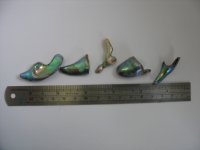R
Richard W. Wise
Guest
All,
Had an interesting conversation with a European pearl dealer about figuring the price of natural pearls. He showed me how to convert carats to grains and figure the wholesale value of an individual pearl or strand. Stands have to be figured one pearl at a time He called this calculation the "one time". I have also heard it called the 'base". The base is then multiplied times the current wholesale price
This method goes back beyond the 17th Century, Tavernier talks about it. This dealer still uses it. Anyone have any comments?
By the way just did part I of a new GemWise blog post on the 2008 Las Vegas Shows. Follow the link below.
Had an interesting conversation with a European pearl dealer about figuring the price of natural pearls. He showed me how to convert carats to grains and figure the wholesale value of an individual pearl or strand. Stands have to be figured one pearl at a time He called this calculation the "one time". I have also heard it called the 'base". The base is then multiplied times the current wholesale price
This method goes back beyond the 17th Century, Tavernier talks about it. This dealer still uses it. Anyone have any comments?
By the way just did part I of a new GemWise blog post on the 2008 Las Vegas Shows. Follow the link below.

